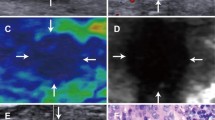Abstract
Purpose
The aim of the present study was to evaluate thyroid nodules using virtual touch quantification (VTQ) of force impulse acoustic radiation (ARFI) imaging and to investigate a cutoff value for the differentiation of malignant thyroid nodules.
Materials and methods
Ninety-five patients with quantitatively-assessed (VTQ) thyroid nodules were evaluated with ARFI imaging in this prospective study. ARFI imaging with VTQ was performed only on the nodules which were expected to undergo fine-needle aspiration biopsy (FNAB). All of the thyroid lesions were examined histopathologically.
Results
The mean shear wave velocity (SWV) value of the malignant nodules (3.18 ± 0.39 m/s) was higher than that of the benign nodules (2.11 ± 0.53 m/s). There was a statistically significant difference between the mean SWV values of benign and malignant nodules (p < 0.001). A SWV cutoff value of greater than 2.66 m/s yielded sensitivity and specificity values of 100 and 82.3 %, respectively, for diagnosis of malignant nodules.
Conclusion
VTQ of ARFI imaging has high sensitivity and specificity for discriminating between benign and malignant thyroid nodules and may positively contribute to clinical evaluation of these nodules.




Similar content being viewed by others
References
Cooper DS, Doherty GM, Haugen BR et al (2009) Revised American Thyroid Association management guidelines for patients with thyroid nodules and differentiated thyroid cancer. Thyroid 19:1167–1214
Mackenzie EJ, Mortimer RH (2004) Thyroid nodules and thyroid cancer. Med J Aust 180:242–247
Hegedus L (2004) Clinical practice. The thyroid nodule. N Engl J Med 351:1764–1771
Frates MC, Benson CB, Charboneau JW et al (2005) Management of thyroid nodules detected at US: Society of Radiologists in Ultrasound consensus conference statement. Radiology 237:794–800
Oertel YC, Miyahara-Felipe L, Mendoza MG, Yu K (2007) Value of repeated fine needle aspirations of the thyroid: an analysis of over ten thousand FNAs. Thyroid 17:1061–1066
Peng Y, Wang HH (2008) A meta-analysis of comparing fine-needle aspiration and frozen section for evaluating thyroid nodules. Diagn Cytopathol 36:916–920
Zhang FJ, Han RL (2013) The value of acoustic radiation force impulse (ARFI) in the differential diagnosis of thyroid nodules. Eur J Radiol 82:686–690
Hou XJ, Sun AX, Zhou XL et al (2013) The application of Virtual Touch tissue quantification (VTQ) in diagnosis of thyroid lesions: a preliminary study. Eur J Radiol 82:797–801
Zhang B, Ma X, Wu N et al (2013) Shear wave elastography for differentiation of benign and malignant thyroid nodules: a meta-analysis. J Ultrasound Med 32:2163–2169
Guazzaroni M, Spinelli A, Coco I et al (2014) Value of strain-ratio on thyroid real-time sonoelastography. Radiol Med 119:149–155
Zhai L, Palmeri ML, Bouchard RR et al (2008) An integrated-ARFI imaging system for tissue stiffness quantification. Ultrason Imaging 30:95–111
Nightingale K, Soo MS, Nightingale R, Trahey G (2002) Acoustic radiation force impulse imaging: in vivo demonstration of clinical feasibility. Ultrasound Med Biol 28:227–235
Gu J, Du L, Bai M et al (2012) Preliminary study on the diagnostic value of acoustic radiation force impulse technology for differentiating between benign and malignant thyroid nodules. J Ultrasound Med 31:763–771
Friedrich-Rust M, Romenski O et al (2012) Acoustic radiation force impulse-imaging for the evaluation of the thyroid gland: a limited patient feasibility study. Ultrasonics 52:69–74
Pacini F, Schlumberger M, Dralle H et al (2006) European consensus for the management of patients with differentiated thyroid carcinoma of the follicular epithelium. Eur J Endocrinol 154:787–803
Nightingale K, McAleavey S, Trahey G (2003) Shear-wave generation using acoustic radiation force: in vivo and ex vivo results. Ultrasound Med Biol 29:1715–1723
Meng W, Du W, Zhang G et al (2011) Acoustic radiation force impulse (ARFI) ultrasound imaging of breast lesions. Eur J Radiol 37:1436–1443
Asteria C, Giovanardi A, Pizzocaro A et al (2008) US-elastography in the differential diagnosis of benign and malignant thyroid nodules. Thyroid 18:523–531
Conflict of interest
The authors declare that they have no conflict of interest.
Author information
Authors and Affiliations
Corresponding author
Rights and permissions
About this article
Cite this article
Hamidi, C., Göya, C., Hattapoğlu, S. et al. Acoustic Radiation Force Impulse (ARFI) imaging for the distinction between benign and malignant thyroid nodules. Radiol med 120, 579–583 (2015). https://doi.org/10.1007/s11547-014-0495-8
Received:
Accepted:
Published:
Issue Date:
DOI: https://doi.org/10.1007/s11547-014-0495-8




